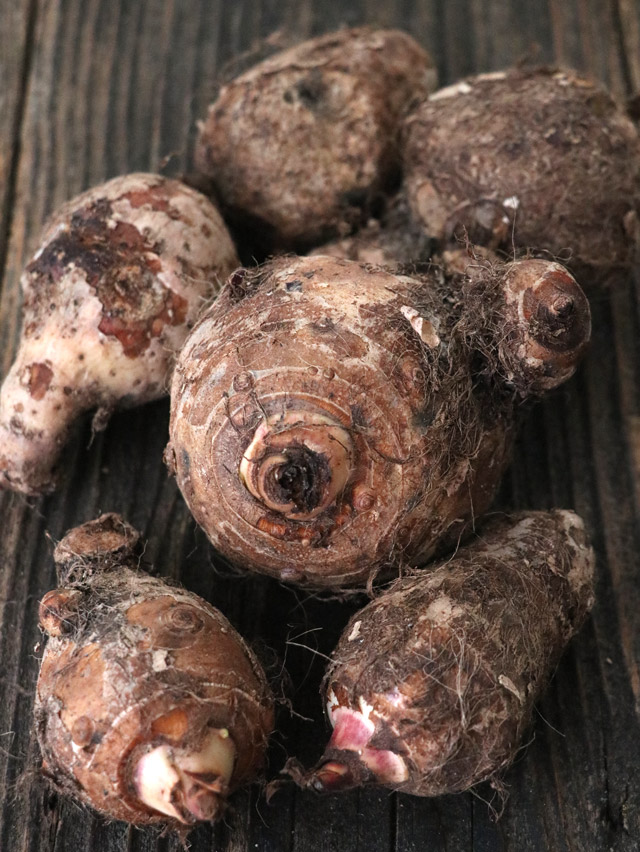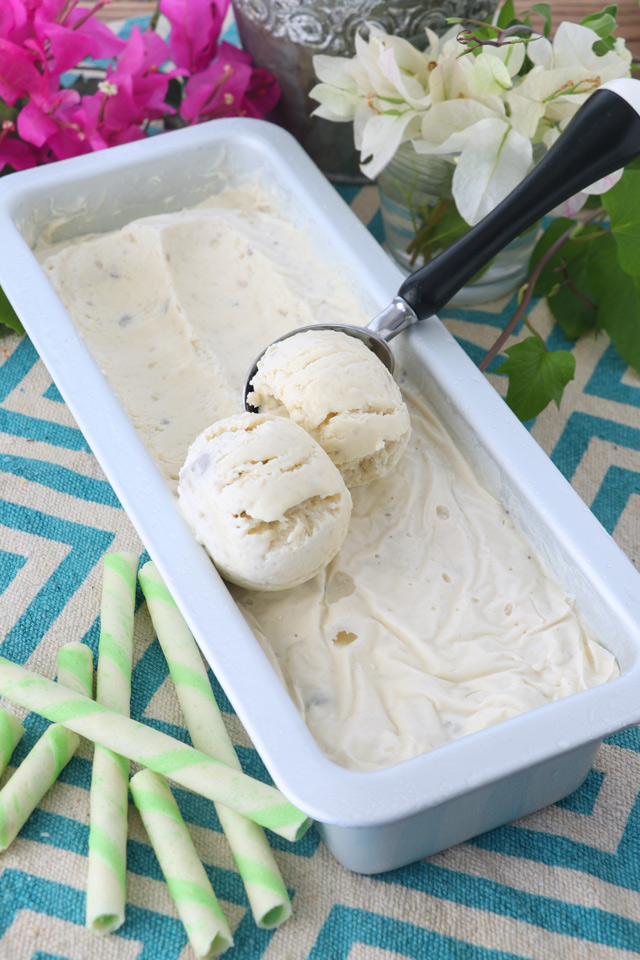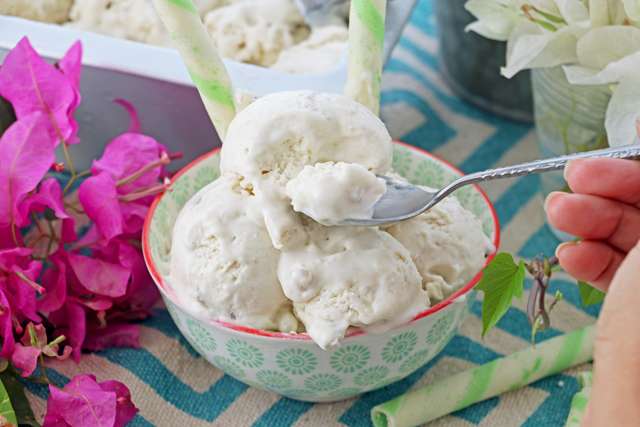Step-by-step taro ice cream recipe, list of taro ice cream ingredients, simple taro ice cream food directions
You may be thinking, Taro? What’s that? If you haven’t heard of this green root vegetable, don’t worry; it’s also called Dasheen and cocoyam, among other names. It originated in Africa but has been grown in Asia and the Pacific islands since at least 3,000 BC. In Hawaii, where I grew up, Taro root was often served as an alternative to potatoes or sweet potatoes and was often used to make ice cream.
Taro or Colocasia esculenta, or taro root or eddo is an edible starchy tuberous root.
For those of you living in the US or Europe, taro may be one of those foreign foods that’s hard to come by. If you’re lucky enough to have access to it, though, taro could be the ingredient you’ve been missing in your ice cream recipes. Taro ice cream is lower in fat than many other ice creams because taro has the ability to turn out creamy like milk with only a fraction of the fat content and added sugar usually associated with ice cream recipes. In this article, we’ll cover how to make taro ice cream, so keep reading!
Taro Ice cream, What is it?
Taro or Dasheen is a root vegetable that has been cultivated in Asia, Africa and the Caribbean since pre-Columbian times. It was also grown in Polynesia, South America and the West Indies.
In some countries it grows wild as an aquatic plant, but it can be grown in almost any tropical climate. Taro does not store well and is sensitive to salinity so care must be taken when cooking with it. The leaves are also edible and can be cooked like spinach or eaten raw in salads.
Taro Ice Cream made of Taro root. Taro is a starchy root vegetable with a sweet, nutty flavor and texture that is similar to a cross between chestnuts and potatoes.
Taro ice cream is a popular Asian dessert that has been around for a long time. It is well-liked in Japan for its delectable and distinct flavor. Taro ice cream is made from the same-named pure white tuber vegetable.
Taro Ice Cream is a traditional Asian ice cream with taro as the main ingredient. When consumed like any other frozen dessert, the umami-filled starch of the taro root lends depth of flavor to this frozen delicacy.
An egg yolk, which adds fats and protein to the recipe, is one way to make your ice cream richer and smoother. It also extends the product’s shelf life by preventing it from melting too quickly before reaching our mouths.
The flavor of taro reminds me of my childhood when I used to eat it in warm syrup, sprinkled with sugar and cinnamon, so naturally I fell in love with taro ice cream the moment I tried it. Whether you want to make taro ice cream for your family or sell it on your local farmers market, you should know that there are two types of taro- purple and white. The white one has less fiber than the purple one, which makes the white one more suitable to be eaten as an ice cream flavor- therefore we will discuss how to make taro ice cream with white taro only.
Taro Ice cream Recipe Facts

Recipe: Taro Ice cream Recipe
Category: Dessert
Cuisine: Asian
Author: LHH Food
Preparation Time:
Cooking time:
Ingredients: Ingredients list here
Instructions: Click to go to process
Servings: 4
Average rating: 4.9 of 5.0 from 346 reviews
Tags: taro ice cream, taro ice cream recipe, taro ice cream food, how to make taro ice cream, taro ice cream recipe video, easy method of making taro ice cream, video on how to prepare taro ice cream, how to prepare taro ice cream, taro ice cream instructions video, taro ice cream recipe methods, taro ice cream recipe tips, taro ice cream recipe pictures, taro ice cream food photos, taro ice cream step by step instructions, taro ice cream cooking methods, taro ice cream methods, taro ice cream cooking directions
About: Taro Ice cream recipe guide. Learn how to make your authentic food, taro ice cream.
Taro Ice cream Ingredients List

- 2 tablespoons unsalted butter
- 2/3 pound grated taro (about 2 cups, packed)
- 2 cups heavy cream
- 1 14-ounce can coconut milk
- 3/4 cup sugar
- 3/4 teaspoon kosher salt
Taro Ice cream recipe step by step
- In a large pot over medium heat, melt the butter. Once the butter has completely melted and the foam has subsided, increase the heat to high and add the taro.
- Cook, stirring regularly while boiling, for about 5 minutes, or until the taro becomes somewhat translucent, begins to color around the edges, and decreases in volume to a soft, starchy ball.
- Before adding the cream, coconut milk, and sugar, scrape any starchy bits from the bottom of the saucepan with a wooden spoon or spatula. Bring to a low boil, then remove from the heat. Cook for 20 minutes, covered, or until taro is completely soft.
- Fill a blender halfway with the dairy mixture and blend on high for 30 seconds, or until fully smooth.
- Pour into an airtight container through a sieve, season with salt to taste, and chill for at least 4 hours until extremely cold.
- Once the ice cream base has cooled, transfer it to an ice cream maker and churn according to the manufacturer’s instructions. Before serving, chill the ice cream for at least 6 hours in an airtight container. Allow the ice cream to soften on the counter for 5 minutes before scooping.
Taro Ice cream food images



Video on How to make Taro Ice cream
Watch the video know-how of Taro Ice cream. Have a audio-visual clue and in depth explanations on how to make taro ice cream. Below is the video on how to prepare taro ice cream.
Learn how to make taro ice cream. This is a video on how to prepare fantastic taro ice cream.
How to make Taro Ice cream, endnote
If you are looking for something new, something different, try making taro ice cream. Taro is a root vegetable related to sweet potatoes. It’s high in fiber and calories so use it in moderation if you are dieting. But in terms of flavor its smooth texture goes well with Asian recipes. This Chinese vegetable can be found fresh or frozen at your local grocery store.
Properly storing taro will help extend its shelf life. Storing in a cool, dry place between 30°F and 40°F is optimal. Light exposure can also cause browning of taro, so keep them in containers or sealed bags that protect them from light as well. It’s best to store them right after you purchase them. Over time, they may turn yellowish-brown, but they’re still safe to eat!